
To calculate: The rate of crossover for two projects.
Introduction:
The
Answer to Problem 13QP
The crossover rate for the two projects is 10.19%. The NPV profiles show that both the projects have a higher NPV for the rate of discount below 10.19% and have a lower NPV for the rate of discount above 10.19%.
Explanation of Solution
Given information:
The details of two projects are provided. The project X cash that flows for year 1, year 2, and year 3, are $10,620, $10,900, and $10,500 respectively. The initial investment is $24,000. The project Y cash that flows for 4 years are $12,100, $9,360, $10,400 respectively and the initial investment is $24,000.
Note:
- NPV is the difference between the present values of the cash inflows from the present value of cash outflows.
- The IRR is the rate of interest, which makes the project’s NPV equal to zero. Hence, when using the available information, assume that the NPV is equal to zero and forms an equation to compute the IRR.
Equation of NPV to compute IRR by assuming that NPV is equal to zero is as follows:
Compute IRR for the project X using a spreadsheet:
Step 1:

- Type the equation of NPV in H6 of the spreadsheet and consider the IRR value as H7.
Step 2:

- Assume the IRR value as 10%.
Step 3:

- In the spreadsheet, go to data and select the what-if-analysis.
- In what-if-analysis, select goal seek.
- In a set cell, select H6 (the Formula).
- The “To value” is considered as 0 (the assumption value for NPV).
- The H7 cell is selected for the 'by changing the cell'.
Step 4:
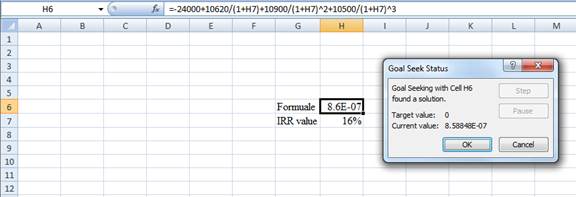
- Following the previous step click OK in the goal seek. The goal seek status appears with the IRR value
Step 5:
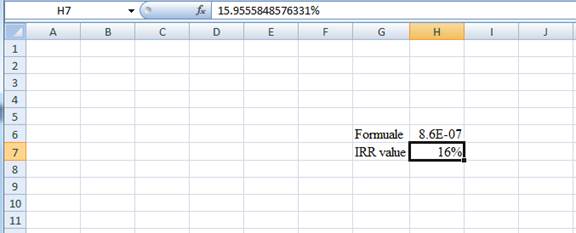
- The value appears to be 15.9555848576331%
Hence, the IRR value is 15.96%.
Compute the IRR for project Y using a spreadsheet:
Step 1:

- Type the equation of NPV in H6 of the spreadsheet and consider the IRR value as H7.
Step 2:

- Assume the IRR value as 10%.
Step 3:

- In the spreadsheet, go to data and select the what-if-analysis.
- In what-if-analysis, select goal seek.
- In a set cell, select H6 (the Formula).
- The “To value” is considered as 0 (the assumption value for NPV).
- The H7 cell is selected for the 'by changing the cell'.
Step 4:
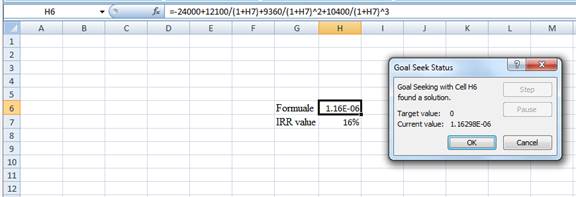
- Following the previous step click OK in the goal seek. The goal seek status appears with the IRR value.
Step 5:

- The value appears to be 16.1307523542427%.
Hence, the IRR value is 16.13%.
Formula to compute the crossover rate is as follows:
Equation of the crossover rate to compute R is as follows:
Where,
“R” denotes crossover rate.
Compute R by using a spreadsheet:
Step 1:

- Type the equation of NPV in H6 of the spreadsheet and consider the IRR value as H7.
Step 2:

- Assume the IRR value as 10%.
Step 3:
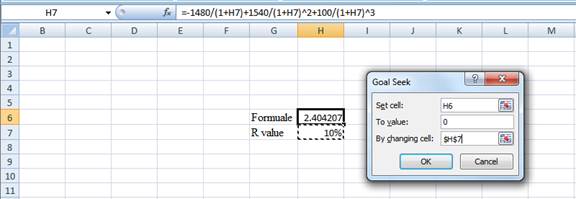
- In the spreadsheet, go to data and select the whatif analysis.
- In what-if analysis select goal seek
- In set cell select H6 (the Formula)
- The “To value” is considered as 0 (the assumption value for NPV)
- The H7 cell is selected for the by changing cell
Step 4:

- Following the previous step click OK in the goal seek. The goal seek status appears with the IRR value.
Step 5:
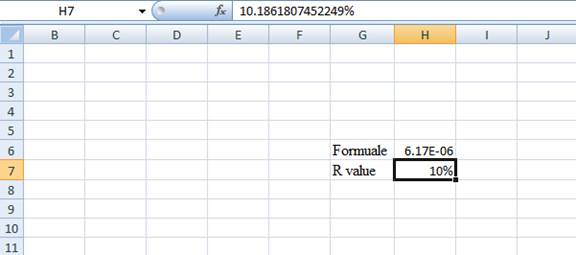
- The value appears to be 10.1861807452249%
Hence, the R-value is 10.19%.
Formula to calculate the NPV is as follows:
Note: As the discount rate is over a range of 0% to 25%, calculate NPV for 0%, 5%, 10%, 15%, 20%, and 25%.
Compute the NPV with the discount rate of 0% for the project X:
Compute the NPV with the discount rate of 0% for the project Y:
Hence, the NPV for the projects X and Y at the rate of 0% is $8,020 and $7,860 respectively.
Compute the NPV with the discount rate of 5% for the project X:
Compute the NPV with the discount rate of 5% for the project Y:
Hence, the NPV for the projects X and Y at 5% is $5071.20 and $4,997.52 respectively.
Compute the NPV with the discount rate of 10% for the project X:
Compute the NPV with the discount rate of 10% for the project Y:
Hence, the NPV for the projects X and Y at the rate of 10% is $2,551.62 and $2,549.21 respectively.
Compute the NPV with the discount rate of 15% for the project X:
Compute the NPV with the discount rate of 15% for the project Y:
Hence, the NPV for the projects X and Y at the rate of 15% is $3,80.67 and $437.41 respectively.
Compute the NPV with the discount rate of 20% for the project X:
Compute the NPV with the discount rate of 20% for the project Y:
Hence, the NPV for the projects X and Y at the rate of 20% is -$1,504.17 and -$1,398.15 respectively.
Compute the NPV with the discount rate of 25% for the project X:
Compute the NPV with the discount rate of 25% for the project Y:
Hence, the NPV for the projects X and Y at the rate of 25% is -$3,152 and -$3,004.80 respectively.
Want to see more full solutions like this?
Chapter 9 Solutions
FUND. OF CORPORATE FIN. 18MNTH ACCESS
- A firm is considering two mutually exclusive projects, X and Y, with the following cash flows: 0 1 2 3 4 Project X -$1,000 $90 $320 $430 $700 Project Y -$1,000 $1,000 $100 $45 $55 The projects are equally risky, and their WACC is 10%. What is the MIRR, Payback Period or Discount Payback Period of project X and project Y. Note: DO NOT SOLVE ON EXCELarrow_forwardThe Weiland Computer Corporation is trying to choose between the following mutually exclusive design projects, P1 and P2: Year 0 1 2 3 Cash flows (P1) -$53,000 27,000 27,000 27,000 Cash flow (P2) -$16,000 9,100 9,100 9,100 If the discount rate is 10 percent and the company applies the profitability index (PI) decision rule, which project should the firm accept? If the firm applies the Net Present Value (NPV) decision rule, which project should it take? Are your answers in (a) and (b) different? Explain why?arrow_forwardY8 For the given cash flows, suppose the firm uses the NPV decision rule. Year Cash Flow 0 −$ 149,000 1 67,000 2 72,000 3 56,000 At a required return of 8 percent, what is the NPV of the project? Note: Do not round intermediate calculations and round your answer to 2 decimal places, e.g., 32.16. At a required return of 21 percent, what is the NPV of the project? Note: A negative answer should be indicated by a minus sign. Do not round intermediate calculations and round your answer to 2 decimal places, e.g., 32.16.arrow_forward
- The Weiland Computer Corporation is trying to choose between the following mutually exclusive design projects, P1 and P2:Year 0123 Cash flows (P1) -$53,000 27,000 27,000 27,000 Cash flow (P2) -$16,000 9,100 9,100 9,100a. If the discount rate is 10 percent and the company applies the profitability index (PI) decision rule, which project should the firm accept?b. If the firm applies the Net Present Value (NPV) decision rule, which project should it take?c. Are your answers in (a) and (b) different? Explain why?arrow_forward(Mutually exclusive projects and NPV) You have been assigned the task of evaluating two mutually exclusive projects with the following projected cash flows: Year Project A Cash Flow Project B Cash Flow 0 $(100,000) $(100,000) 1 33,000 0 2 33,000 0 3 33,000 0 4 33,000 0 5 33,000 220,000 If the appropriate discount rate on these projects is 10 percent, which would be chosen and why? The NPV of Project A is $ (Round to the nearest cent.) The NPV of Project B is $ (Round to the nearest cent.) Which project would be chosen and why? (Select the best choice below.) A. Choose Upper B because its NPV is higher. B. Cannot choose without comparing their IRRs. C. Choose Upper A because its NPV is higher. D. Choose both because they both have positive NPVs.arrow_forwardHere are the cash flows for a project under consideration: C0 C1 C2 −$7,510 +$5,420 +$19,200 a. Calculate the project’s net present value for discount rates of 0, 50%, and 100%. (Round your answers to the nearest whole dollar.) b. What is the IRR of the project? (Do not round intermediate calculations. Enter your answer as a whole percent.)arrow_forward
- 17. Consider the following two mutually exclusive projects: Year Cash Flow (A) Cash Flow (B)0 −$291,000 −$41,6001 37,000 20,0002 55,000 17,6003 55,000 17,2004 366,000 14,000 a) What is the Internal Rate of Return (IRR) for each of these projects? b) Using the IRR decision rule, which project should the company accept? c) If the required return is 11 percent, what is the Net Present Value (NV) for each of these projects? d) Using the NPV decision rule, which project should the company accept? e) Why do you think the NPV and IRR rules do not agree on same project approval/rejection direction?arrow_forwardNet Cash Flows and NPVs for different discount rate for projects S and L are given below Net Cash Flows ($) Discount Rate (%) NPVS NPVL Year (t) Project S Project L 0% $800 $1100 0 $(3000) $(3000) 5 554.32 1 1500 400 10 161.33 2 1200 900 15 (90.74) (259.24) 3 800 1300 20 (309.03) (565.97) 4 300 1500 g) If projects are mutually exclusive, which project would you accept? i) at 5% ii) at 15% h) If projects are independent (not mutually exclusive), which project(s) would you accept? i) at 5% ii) at 15%arrow_forwardFind the crossover rate. UF Company is considering Projects S and L, whose cash flows are shown below. These projects are mutually exclusive, equally risky, and are not repeatable. WACC: 7.75% Year 0 1 2 3 4 CFS ($1,050) $700 $625 CFL ($1,050) $370 $370 $360 $360arrow_forward
- Consider the following two mutually exclusive projects: If the discount rate is 10%, what are the NPV of Project A and the IRR of Project B? Cash Flows ($) Project C0 C1 C2 C3 A -90 +60 +50 0 B -100 0 0 +140 Multiple Choice Then NPV for project A is $5.9 and the IRR for project B is 11.9% Then NPV for project A is $8 and the IRR for project B is 9% Then NPV for project A is $20 and the IRR for project B is 11.9% Then NPV for project A is $5.9 and the IRR for project B is 11.9%arrow_forwardConsider the following two mutually exclusive projects:Year Cash Flow (X) Cash Flow (Y)0 -$365,000 -$38,0001 25,000 16,0002 65,000 12,0003 65,000 17,0004 425,000 15,000Whichever project you choose, if any, you require a 13 percent return on your investment. i. Which investment will you choose if you use the payback decision criteria? Justify your answer.ii. Which investment will you choose if you use the NPV decision criteria? Justify your answer.iii. Which project will you choose ultimately based on your answers above?arrow_forwardConsider the following two exclusive projects, A and B: Project 0 1 2 3 4 Discount Rate A (100,000) 15,000 40,000 50,000 65,000 10% B (55,000) 30,000 30,000 30,000 30,000 10% Which project would you recommend investing in? Project A and B Project B Project A None of the abovearrow_forward

